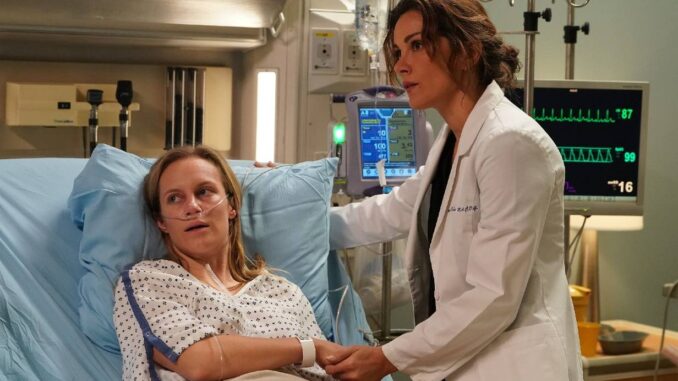
The Shattered Mirror: How Station 19 Episode 7 Broke the Usual Grey’s Anatomy Crossover Formula
The Shondaland universe, particularly the intertwined worlds of Grey's Anatomy and Station 19, has long relied on a dependable, almost ritualistic, crossover formula. Like two planets with intersecting orbits, the shows periodically collide, usually around a cataclysmic event – a multi-car pileup, a massive fire, an earthquake – where characters from one series parachute into the other’s domain to offer specialized expertise. A doctor might stitch up a firefighter, or a firefighter might rescue a doctor from a burning building. These encounters, while often exciting, frequently felt like carefully choreographed cameos, momentary brushstrokes on separate canvases.
Then came Station 19 Season 3, Episode 7, titled "Poor Judgement" (and its Grey's Anatomy counterpart, Season 16, Episode 10, "Help Me Through the Night"). This two-hour event didn't merely intersect; it detonated the established formula, shattering the comfortable illusion of two distinct narratives and forging, instead, a single, agonizingly coherent story. It was less a crossover and more a shared trauma, a brutal redefinition of interdependence.
The "usual formula" often began with a shared disaster. A crane collapses, a ferry boat sinks, a building explodes. The crisis would be grand in scale, a perfect canvas for both the fast-paced heroics of Station 19's firefighters and the high-stakes surgical drama of Grey Sloan Memorial. Firefighters would be seen on the scene, pulling victims from wreckage, while their medical counterparts would be busy in the ER, intubating and operating. Characters like Ben Warren, the former surgeon turned firefighter, or Miranda Bailey, his wife and Chief of Surgery, served as the primary conduits, providing a familiar face and a reason for the two worlds to momentarily touch. Yet, the impact was largely functional. Once the crisis was averted, the firefighters would return to their station, the doctors to their wards, their individual character arcs largely unaffected by the fleeting interaction. A few lines might be exchanged, a shared glance of exhaustion, but the emotional ripples rarely extended beyond the immediate scene. It was two ships passing in the night, briefly illuminating each other before sailing back into their own narratives.
Episode 7, however, discarded this polite intersection for a full-blown collision. The catalyst was not some distant, impersonal disaster, but a deeply intimate tragedy: a car crashing through the wall of Joe's Bar, a beloved, iconic safe haven for the Grey's Anatomy characters for sixteen seasons. The sheer audacity of this choice immediately elevated the stakes. This wasn't just a bar; it was the bar. And the victims weren't anonymous extras; they were beloved recurring characters, including Grey Sloan residents Dr. Helm and Dr. Schmitt, and most devastatingly, members of Station 19's own family, like Chief Pruitt Herrera and Ben Warren himself.
The immediate consequence was a visceral shock that permeated both shows. The Station 19 episode plunged us into the immediate, horrifying chaos. We saw the firefighters, not just as saviors, but as victims and first responders simultaneously, battling impossible odds to save their own. The emotional weight was palpable as Andy battled to save her father, Pruitt, and Ben Warren, caught between his firefighter instincts and surgical training, desperately triaged the injured, including his former colleagues. This wasn't Ben making a quick diagnosis and handing off a patient; this was Ben, deep in the thick of it, battling the clock, his own fears, and the ethical dilemmas of a man with two callings.
But the real disruption occurred in the aftermath, as the crisis unfolded and bled into the Grey's Anatomy hour. The injured were brought to Grey Sloan, not as generic patients, but as friends, colleagues, and spouses. The trauma wasn't contained to the accident scene; it saturated the entire hospital. Dr. Miranda Bailey, reeling from the loss of her unborn child, had to face the possibility of losing her husband, Ben, again. Dr. Maggie Pierce, usually stoic, broke down witnessing the devastation. And perhaps most significantly, Dr. Andrew DeLuca, already struggling with his mental health, was pushed over the edge. The stress, the perceived failures, and the overwhelming grief triggered a profound mental breakdown that became a central, ongoing storyline for both shows.
This was the pivotal departure: DeLuca's mental health crisis wasn't a contained Grey's plot point that happened to be influenced by a Station 19 event. It was a shared consequence, a narrative thread spun from the trauma that connected both series inextricably. His increasingly erratic behavior and subsequent diagnosis became a narrative through-line that forced both casts to grapple with the fallout. Station 19 characters, having witnessed his breakdown firsthand at the bar, were as invested in his well-being as his Grey Sloan colleagues.
The episode broke the formula by refusing to neatly compartmentalize the emotional and narrative impact. The wounds inflicted weren't just physical; they were psychological and relational. The loss of lives, the near-deaths of beloved characters, and the subsequent mental health struggles meant that the characters of Station 19 weren't just visitors in the Grey's Anatomy world, and vice versa. They were citizens of a shared, wounded landscape. The shared tragedy created a narrative tapestry where individual threads from both shows were woven together, rather than merely laid side-by-side.
Station 19 Episode 7, and its Grey's counterpart, didn't just present a larger emergency; it presented a deeper, more integrated emotional reality. It transformed the crossover from a functional device into a narrative imperative, forcing both shows to acknowledge their profound and painful interdependence. By shattering the mirror that once separated their worlds, the episode allowed audiences to see the reflection of a truly unified, and utterly compelling, dramatic universe.
